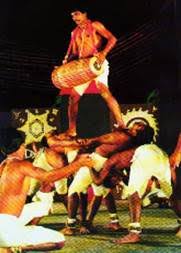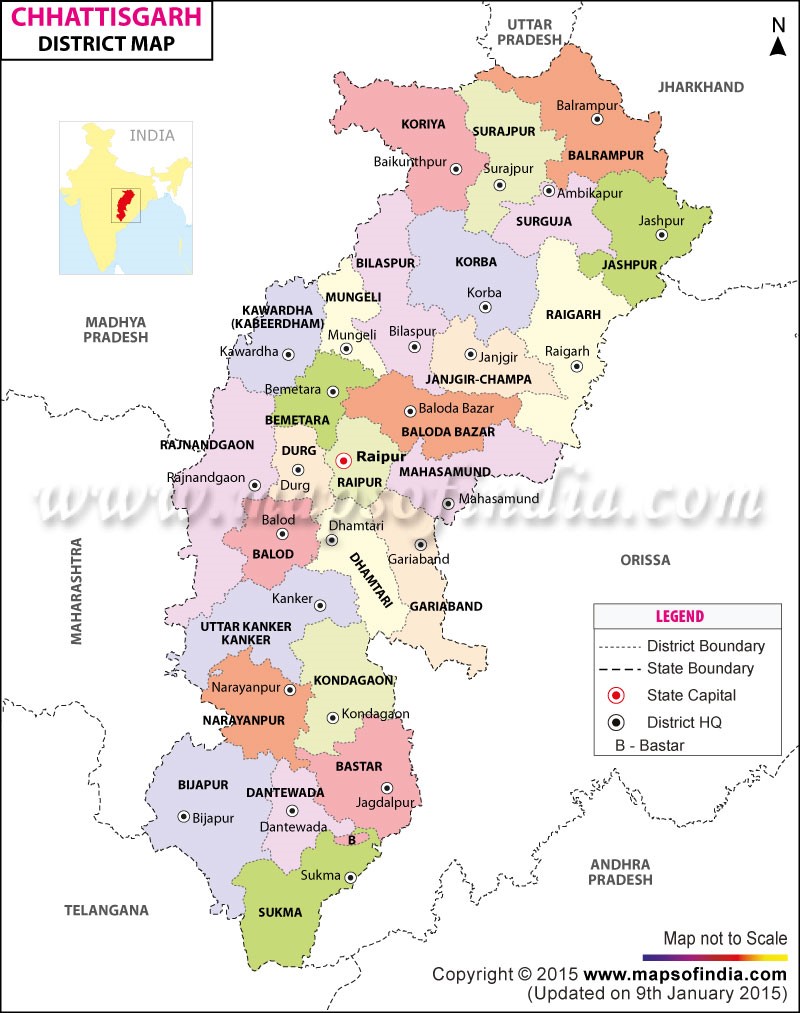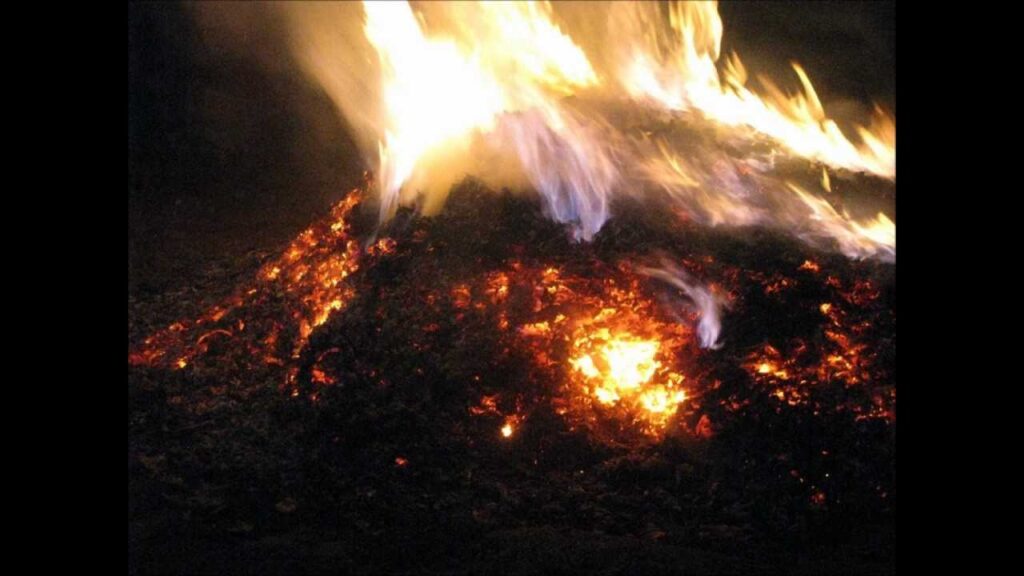The Traditional Identity of The Folk Music of Chhattisgarh
Dr. Asish Chakraborty
Introduction

Nature is an indispensable part of human race and society, as has given birth to it and nourishes every moment through untiring supply of all needs. Unlike the other lively creatures of earth the livelihood of human beings has totally been depending on it according to the physical and mental requisite, since its first trace of existence. As to emphasize on human culture the nature’s invincible contribution, is to be focused in a precise manner. The culture of human society is directly involved and inspired by nature, on contrary they both are inseparable. In fact all the cultures existing on the earth has been derived from nature and through a continue practice for eras it has rendered a core effect to form a heritage for human society, is consequently called as folk culture. One of these culture, the folk music culture of Chhattisgarh, as per the topic, we are going to explore about. It is regarded as a backward state, mainly dominated by tribal population. The state is rich in culture field with flora and fauna and the people are the friends of jungle, counted as an indispensable part of their life. Geographically it is situated at the heart of India. The state is endowed with the rich cultural heritage and traditions. The land is completely surrounded by hilly areas and planes, adorned with its natural beauty including dense forest, mesmerizing waterfalls, land scape, and assorted wildlife.

Basic Folk Music Culture of Chhattisgarh
Chhattisgarh, has a rich folk culture and being maintained by the inhabitants as their traditions, very caressingly, as an entity of their heritage. Music of Chhattisgarh is deeply related with relevant Dance form in maximum cases, because the traditional ceremonial performances is meant to offering and enjoying the entire repertoire, to the inhabitants and they give their fullest while doing. In order to do that through the music by all means, Dance cannot be taken apart because body movement adds an extra feather to the emotional urge of the purpose. Therefore, while describing the Music forms underneath, we may also touch and explore the relevant dance forms as well, excluding of which the full profile of them cannot be accomplished. But before exploring the concerned changes we need to be clear about the Idea of Lok Geet or Folk Song and Local Song. Local song is written in local language but that is not Lok Geet or Folk song. The famous Chhattisgarhi Folklore specialist and researcher Mr. Niranjan Mahavar has explained beautifully about this idea. According to him the local song is Lok Bhasha Geet or the song composed in local language merely, thus cannot be embraced as a folk song. A folk song must have had its tradition and heritage. The Karma, Dadaria, Sua, Mata Seva Geet, Phag Geet, Jas Geet, Sohar Geet etc all are in this Folk song Category because all of them have got a deep heritage.
In Folk songs the feeling and emotion of the common people is the key thing that exists. That is why the main emotion of it, acts like a person in the songs and be always free from the constraints of the theories and typical norms of the basics of music. Normally there is no scripture where from they are followed precisely but rather the emotion speaks always. Mr. Niranjan Mahawar said very clearly that we can hardly find the lyricist and composer of Folk music but due to the practice singing from a long time span it is set to our mind and voice and thus continues its journey onwards.
Classification of Chhattisgarhi Folk Song:- The folk songs of Chhattisgarh area could be divided into four categories.
Some of these songs along with adequate details has been given below:
Sohar Geet
At the eve of a child birth Sohar Geet gets performed by the local women to wish the child and the mother for a long and healthy life. The comprising of this kind of songs are mainly about the labor pain of the mother, conversation between Nanad and Sister in law, the birth of Lord Rama and Krishna etc. take place. Although in this segment yhere are several kinds of songs for the different stages of conceiving and delivery. After the successful completion of fifth month of pregnancy the relatives of in laws starts celebrating. Even when the labor pain rises up and being intolerable for the mother, depicting all these, there are some particular songs as well. Here is an example of Sohar Geet given below.
Song: – “Sate sakhi aagu chale, sate sakhi chale, sate sakhi ho lalana
Beech me dashada maharani chale ho Yamuna paani ho
Vivah Geet
Vivah means marriage. According to Chhattisgarhi rituals in marriage there are several kind of segments or slots of this ritual i.e. collecting soil from local pond to make a local oven at home called ‘ Mangni, Chulamati, then Tel chadhi ( Oil and Turmeric coating to bride groom) , Inviting the deities, Maap Moudi (Roti ritual),Nahdholi ( Bathing ritual), Pardhani (welcoming the Groom Party), Hardahi game, Madbani, Samdhi, Samdhin, Dulha, Dulhan, Bhaoji, Kanyadan, and at last Vidai Geet ( departing of bride from her home). For each and every segment there are special songs. One example of TelChadhi Geet is given below.
“ Ek tel Chadhge Ho hariyar hariyar
Mandva ma dhularu to badan kumhalay
Ram Lakhan ke ho Ram Lakhan ke
Tel o chadhat hai Kanhaba ke diyana hove anjor”-
Mrityu Geet

Kabir Panth and Satnaami Panth both have made their deep impact on the state along with the Mahanadi Basin area. The Kabir Panth of Sage Dharamdas and Satnami Panth of Guru Ghasidas both are the believers of ‘Niguna Man’. The Mrityu Song or the song of demise these both have explained in the same way and rather emphatically.Both of them said the sole is immortal and unleashed. One of the songs has given as an instance.
Humko uda do chadariya kale ke bera hai
Sangi saathi jarkar aaye aaye
Angna me khade bartiya
Charjane mil bohkar le gaye
Bhojli Geet
Bhojli ceremony gets celebrated in the entire time span, from Nag Panchmi to Raksha Bandhan. With the touch of rainy season, after intolerable summer, the nature herself turned up with its utmost productivity. New corps, new life, new enthusiasm erupts with endless delight. This time the farmers sow the seeds to grow crops and for that they celebrate this ceremony through some rituals and expect the good crops as a boon from Bhojli mother.First they welcome mother Ganges through the song given below:
Aho Devi Ganga,
Devi Ganga, Devi Ganga, lahar turanga
Hamar Bhojli Dai ke Bhije Aatho Anga.
[ Hail Goddess Ganges your waves are drenching eight limbs of our Bhojli Maa]. Apart from this, for welcoming Rainy season the local women sing the songs
Maata Seva Geet
This kind of song is specially sung for being cured or staying safe from the pox, one of the most contagious diseases. There is a strong believe exists among the local rural people that if they please Shitala Maata, the deity of this disease by their offerings, as a boon she could bless them of staying safe from it. One part of this type song as an example is given below:
Sharda Maay saraswati Bhabanila
Bando karajod ho may
Bhule akshar devi kah samjhabe
Kanthe baithmukh bol ho may.
Suva Geet
Suva is basically a dance style performed by women only. Mails are not allowed to take part. Suva dance is accompanied by Suva geet. In this ceremony a replica of a parrot is kept, symbolizing the emotion of soul, abiding that they share their pain with that. They make a nest of Suva in a basket and keep the replica there, surrounding that they dance and sing. While dancing they clap and act like parrot. Suva geet is composed in very simple but rich literature. One example is given below:
Saas mor moray nanad gaari devay
He suvana! Ke raja mor gaye hai videsh
Lahura devar more janam ke bayri
Re suvana! Le jabe tiriya sandes
Goura Geet
Goura is the Goddess of Gond tribe, largest in number amongst all tribes. This goddess is being worshipped from Navratra till Dussehra. They sing Bhajan along with doing the worship. Apart from Gond, some other tribes are doing this aas well. One song given below as an instance.
Ek patri raini jhaini ray rattan durga devi
Tor shital chhav may jaago gouri jaago gouri
Jaaago sahar ke log
Jhain jhain jhule jhare, sejri bichhay
Phaag Geet
Phaag is the name of Holi which is equallyimportant like Deepavali to the people of India. It mainly celebrates the timing of harvesting Rabi crops. This happens in spring season. All the way the nature is fully garnished and adorned with all beauty of it. People celebrate with different type of colors and at night they sing Phaag geet along with nagada.
Baaje nagada dasao jaoriha radha kishan khelay holi
Duno haat dharei pichkari dharei pichkari
Rang gulal sabei bori, haan radha kishan khelay hori
Before start the actual song the singers sing for the deities for offering their devotion
Chala haan re pahile, sumiro Ganapati ko na
Jinki Parvati hai may, re pahile sumeero
Chalaa haan re Gajanan sab devan me aguva hai
So pujo dhyan lagaye.
In Phaag Geet love and Holi playing between Radha Krishna and Lord Rama and Sita make the matter.
Hori khelay birij ma Kanhaiyan
Hori khelay birij ma
Kakar haat ma rang katora
Kakar haat pichkari!
Radha ke haat ma Rang katora
Krishna ke haat ma pichkari…….
Raut Dance Song
Raut is an exclusive cast of Chhattisgarh, one of the most important amongst all the casts dwell in the state. Basically they are Pashu Palaks although they think themselves as the successors of Yadav family. Govardhan Puja in Diwali is their main ritual.They start their dancing ceremony in ‘Kartik Ekadasi’. On the second day they place a pole (Maatri Stambh) by digging soil and worship that. Nextly they gift some garland of peacock feather to the cattle of their clients and dance at those concerned houses.
Dhan godani bhuina pawa, pawa humar asis
Nati put lai ghar jaabe, jiba lakh bais.
Some other copulates are as follow:
Bhanta dekheb dumdumia, ulhere dekheb gay ho,
Aadhe dekhab kaari kamaria, aaohi nanad ke bhay ho.
Nadi teer ma chandan rukhba, je tar maadhe duihan ho,
Dara dara ma pandra Bachura, palha bagar gay gay ho.
Karma
Karma is a main Dance form of Gond tribes. Gond is the main tribal community of entire Chhattisgarh region and second largest in Central India. Apart from Gond of this area, Raigar’s Uraon, Mandla’s Baigas, Bilaspur’s and Sargujas Korba and Baghelkhand’s Gond and Baigas perform this dance. Basically from Satpura Range to Mekal and Pathar of Bastar, all Gond tribes are mainly doing this dance form but other tribes also embraced this form to their practice and perform accordingly in concerned festivals. Factually, Music is unlike the stream of water or blow of fresh breeze that renders the effect indiscriminately to all people around. Thus, although Karma is an entity of Gond tribe, whether could be any of the Gonds from other places as well, all the villagers of the state embraced it to their culture.
There is a legend, popular in Northern India, of Dharma and Karma. There are two causes behind the progression of human race- 1. Dharma, which runson the track of norms and ideology and the another one is 2. Karma, which booms us to endeavor in all perspectives. Without these nothing is possible to do in life. The tribal people entirely follow the senses of these two motivating factorsin their life thus eventually very less corruption could be found in their society.
According to the legend Karmasen was a king who confronted many type of hostility in life. He started worshipping God to come out of the situation and succeeded. Thus he, as a gratitude to the almighty expressed his offerings through song and dance. There from Karma started its journey. According to the legend, king Karmasen, after his death became Karma Tree. Young man and women, that’s why, by placing a Karma Tree, dance around, this is what actually Karma dance. It is also the main music of Ghasia tribe because according to another legend Karmasen was born at one of the house of the Ghasias. About the derivation of the Karma one song is given below-
Karmaseni ke aawati, jaani suni pawati
Ahan Ram Ghasi ghar, lihe Avtaar
Aho Ram Chowk Chanden, Pidhli Madhaye
Milhar ke daar tutge
Aho sakhi,
Karma dance and song is called as ‘Geeto ka Raja’ means ‘The king of all songs’ because the variety of style it has got, no other Chhattisgarhi song have it. There are 14 types of dancing style in Karma. It is basically the dance of joy and delight and that give an extra flavor of vivacity. Karma dance starts with some ritual in Bhadra month Shukla ekadasi. The young boy and girls situate a branch of Karm tree at the center point of the performing lawn and worship that in a traditional way. Some varieties of Karma are Lagda, Jhumar, Lahki, Thada, Ragini etc, which could be recognized on the basis of their dance style. Karma dance style, as said, starts with offering God through some particular traditional ritual.
Pahli panvaro Gouri, pher gavo debi Sharda
Kakar gavo, kakar bajavo kakar karo parnam
Guru ke gavo, dev ke bajavo, Sarsuti ke karo parnam
Kahan baythe jogni, kahan baithe devi Sharda
Kahe ma guru banahi
Dadaria
The word Dadaria might have been derived from the Sanskrit word ‘Dvidaria’. These are basically the couplets, actually sung in the field during cultivating or harvesting the crops, or during collecting Mahua flower or during some other works, by young couples. This song is based on some questions- answers asked by the boys to the girls or the visa versa, always give a gesture of love, dating and adequate things. They are composed in the field itself while doing concerned works out there. When these all couplets are accumulatively sung with a basic time cycle or taal then it is called as ‘Salho’. At the starting the boy intimates the girl rather allegorically to be alert and listen to it minutely because he is going to propose his love to her:
Batki ma basi, chivti ma dhare noon
Mai gavat hou dadaria, te kaan dhare sun
After this the boy says again:
Datvan la karei bahera rukh ke
Ek boli suna de apne mukh ke
Then the girl answers:
Ek thin ama ke dui fanki
Mor aankhiv aankhi jhuleithe torech aankhi
Means one bisected mango as possess a gap as if your eyes are staring on my eyes every time.
Chaalni maa chalev supa me phunev
Torkaaran bar thura sayar dhaneyv
[I have done everything to get you in my life].
Pandwani
Pandwani is basically a Katha singing style of Chhattisgarh.Verbal traditional Pandwani is mainly sung by the Pardhan and Devar.Although this Katha singing theme has been derived from Mahabharata but many distortion has happeed to it. More over some local myth from Gond folk tales has been piled up with it.Although present Pandwani that has been being impended on the stages is basically a solo presentation of Mahabharat epic but as said arlier, according to that the main hero of the Katha is Bheema, the eminent war of Kurukshetra is called as the war of Mahadhan. The city of the Pandavas is called as Jeyta instead of Indraprastha and the domain of Kouravas is named as Hasna which might have derived from the word Hastinapur. According to the main Pandwani The Kauravas were 21 brothers instead of 100.Pardhan’s Pandwani the folk themes were been emphasized upon, where as in Jhaduam Dewangan or Teehen Bai’s performance this thing is absent but totally based on The Mahabharata of Sabal Sing Chouhan. Pardhans Pandwani gets rendered in such a way that it appears as the local creation and perspective.
Padwani ( Pardhan)
Kanwra Pandvon ka Danda Dahori khel-
Jaita nigari me panch pritur pandava
Aur hasna nigari me ekkis bhai kanwra hai re bhaia
Ramayni is also a ‘Katha’ singing style, is sung mainly by Pardhans and derived from the epic Ramayana but the key character is Lakshman instead of Rama. The main focus is on this character has added a unique taste to the repertoire moreover some character of Mahabharata has also been compiled with it very successfully. Here we may see the example from the chapter ‘Lakshman ki sat pariksha’
Lachhman Aur Indar Kamni
Hund mahal ke basera bane hai re bhaia
Sat kotha sattar darvaja bane hai bhai
Bawan khirki lage havein re dada
Naag ke khura resham ke guthna
Ek ajgar mudesa, ek gudesa hai re bhai
Palaka par soy rahe hei tapsi lachhman ho
Ho indar kamniatra machhi banke chipke havei
Rasta deikh rahe hei. Kah thei soye havei beiree
Conclusion:
We have discussed till now, some of the main folk music forms of Chhattisgarh with every relevant character wise detailing. The fragrance of folk culture is indispensably being carried by the folk music of any region and without that the entity of any community is definitely baseless. Unfortunately now a days Due to massive industrialization and consequent urbanization, the core character of the folk fragrance is being annihilated. Its, as a whole, is not about only Chhattisgarh but all the communities are supposed to be conscious about the purity and sanctity of their heritage and traditions which is needed to be preserved because the disappearance of cultural identity is just like a body without spine.
Author : Dr. Ashis Chakraborty